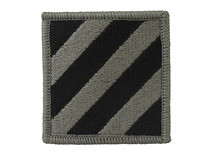Trevor set out to advance his career by entering military service, only to face an abrupt shift of roles the invasion of Iraq placed on many soldiers. At one point in the play, Trevor mentions that he joined the army to be a clerk, to learn a trade. Due to the necessities of the Iraq war however, there is no clear division between the clerks and the soldiers- even “support elements” like Trevor conduct patrols, protect convoys, and face roadside IEDs, suicide bombers, and non-military insurgents. In the war in Iraq, everyone is on the front line.
For nearly half a century the military has promoted itself as an opportunity to learn valuable career skills, but in the modern age of counter-insurgency and counter-terrorism, it has proven impossible to separate even the “cooks and clerks” from the career soldiers- when the Iraq War first began, entire divisions of the military were stretched thin on a high speed armored dash to contain Iraq’s major military resistance, and to project US forces to places like Baghdad as soon as possible. The result was that entire brigade combat teams were deployed wholesale, often strung out in long supply chains, often with the support elements, the cooks and the clerks, alongside and sometimes facing as much hostile fire. While the military was stretched thin before the strategy of the current, force-heavy, human presence of the “Surge,” Guard and Reserve elements were also facing militias and insurgents on street patrols alongside full-time career soldiers. In short, anyone and everyone in today's ground forces faces at least some degree of very real danger of combat action in Iraq. This is an essential component of Trevor's character and his journey, one we don't see on stage, but we do see on his uniform.
Trevor’s uniform marks him as a very particular kind of soldier, and ties his service to a very particular time window of the Iraq war. Since Trevor wears the old Desert Camouflage Uniform, which predates the green-grey Army Combat Uniform, we know that his time in Iraq was most likely sometime between 2003 and late 2006. The pre-surge numbers of soldiers deployed in theatre meant that those there would more likely be called upon for combat duties, regardless of specialty. Even the cooks and clerks had to fight.
But Tr
 evor is not entirely unprepared. On his right shoulder, Trevor wears a “combat patch.” This is the patch of the larger unit he was assigned to when he saw
evor is not entirely unprepared. On his right shoulder, Trevor wears a “combat patch.” This is the patch of the larger unit he was assigned to when he saw  combat, and is now authorized permanent wear regardless of whichever other unit he transfers to. On his left shoulder, he wears the patch of the unit he currently serves with, and more specifically ties him to the 167th Support Division (left), which would fit with his stated career path as a clerk. His combat patch is of the 3rd Infantry Division, (square, right) a much larger unit and one of the Army’s oldest and biggest and most distinguished. At least some element of the 3rd has been deployed to Iraq at every point since the initial invasion.
combat, and is now authorized permanent wear regardless of whichever other unit he transfers to. On his left shoulder, he wears the patch of the unit he currently serves with, and more specifically ties him to the 167th Support Division (left), which would fit with his stated career path as a clerk. His combat patch is of the 3rd Infantry Division, (square, right) a much larger unit and one of the Army’s oldest and biggest and most distinguished. At least some element of the 3rd has been deployed to Iraq at every point since the initial invasion. Trevor also wears specialty insignia which allude to his training in a ground combatant role. He wears the Army’s Air Assault wings (left, with helicopter center), which identify him as having trained to conduct airborne helicopter operations. More coveted that the Air Assault pin is the Army’s Airborne “jump wings,” (left, with parachute) which indicate that he has attended the
Trevor also wears specialty insignia which allude to his training in a ground combatant role. He wears the Army’s Air Assault wings (left, with helicopter center), which identify him as having trained to conduct airborne helicopter operations. More coveted that the Air Assault pin is the Army’s Airborne “jump wings,” (left, with parachute) which indicate that he has attended the  Army’s basic paratrooper training. Both of these badges mark him as a very capable soldier.
Army’s basic paratrooper training. Both of these badges mark him as a very capable soldier.In the military, unlike almost any other profession, personal history and credentials are worn and displayed openly, rather than noted in a résumé. Perhaps if Trevor’s true personality could be displayed as openly as those insignia, he could more easily relate to those around him. But for Trevor, a uniform can only capture one tiny piece of his person, one dimension of his conflicted psyche. Despite the simplicity of the story that the patches tell, there is much more to Trevor, and to life, than can be indicated by a man's rank.





No comments:
Post a Comment